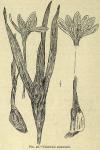 The corm and the seed of Colchicum Autumnale Linné.
The corm and the seed of Colchicum Autumnale Linné.
BOTANICAL CHARACTERISTICS.—Col'chicum autumnal'e Linné, Corm fibrous-rooted. Leaves about a foot long. Flowers several, lilac or purple, appearing in the autumn without the leaves.
HABITAT.—Europe and North Africa.
HABIT OF PLANT.—Flowers in autumn; the leaves appear in the spring.
In the latter part of spring a new corm begins to form at the expense of the old one. In September the upper portion of the flower emerges from the spathe just above ground unaccompanied with leaves. The rudimentary fruit at the base of the flower, below ground, in the following spring rises upon a stem above the surface, in the form of a 3-celled capsule. At the same time the leaves appear; so that, in fact, the leaves follow the flower, instead of preceding it. During the development of the fruit the new corm has been developing at the expense of the old parent one. It will be seen that the medicinal virtues depend upon the time of collection. Early in the spring it is too young, and late in the fall the parent corm has become exhausted by the nutriment furnished to the new plant. The proper period for collection, therefore, is said to be from June to the month of August, although April roots have been found to be of superior efficacy.
68. Colchici cormus.—Colchicum corm.
The dried corm of Col'chicum Autumnal'e Linné, yielding by the official process not less than 0.35 per cent. of colchicine.
 DESCRIPTION OF DRUG.—An ovoid corm about 25 to 40 mm. (1 to 1 3/5 in.), long flattened and deeply grooved on one side; when dried and deprived of its outer membranous covering it is wrinkled and of a brownish-gray color; internally whitish. It often comes into market in transverse starchy slices having a reniforin outline, due to the lateral groove; inodorous; taste sweetish, bitter, and somewhat acrid. A very deep or large notch in the slices indicates that the corm has been partially exhausted by the offset which springs from the base.
DESCRIPTION OF DRUG.—An ovoid corm about 25 to 40 mm. (1 to 1 3/5 in.), long flattened and deeply grooved on one side; when dried and deprived of its outer membranous covering it is wrinkled and of a brownish-gray color; internally whitish. It often comes into market in transverse starchy slices having a reniforin outline, due to the lateral groove; inodorous; taste sweetish, bitter, and somewhat acrid. A very deep or large notch in the slices indicates that the corm has been partially exhausted by the offset which springs from the base.
Powder.—Microscopical elements: See Part iv, Chap. I, B.
CONSTITUENTS.—Colchicine, a methyl derivative of colchiceïn as will be seen from the following: Colchiceïn, C15H9(NHCOCH3)(OCH3)3-COOH; colchicine, C15H9(NHCOCH3)(OCH3)3COOCH3. With mineral acids colchicine yields colchiceïne and methyl alcohol. Starch, gum, resin, fat, and sugar are also present.
Preparation of Colchicine.—Exhaust with alcohol, dilute with water, filter; add lead subacetate to precipitate coloring matter; add sodium phosphate to remove lead; precipitate solution with tannin, wash the precipitate and digest with lead oxide, dry, and dissolve out colchicine with alcohol. Occurs in whitish amorphous powder or crystals; odor saffron-like, taste bitter.
ACTION AND USES.—Colchicum is a gastro-intestinal irritant; the larger therapeutic doses sometimes cause nausea, vomiting and diarrhea. In poisoning there is intense gastro-intestinal irritation, bloody stools, irritation in the kidneys, sometimes an ascending paralysis. It is chiefly employed in gout and rheumatism, in which it is said to be very efficacious. Dose: 2 to 8 gr. (0.13 to 0.5 Gm.).
- OFFICIAL PREPARATION.
- Extractum Colchici Cormi, Dose: 4 gr. (0.25 Gm.).
69. Colchici semen.—Colchicum seed.
The seed of Col'chicum autumnal'e Linné, yielding by the official process not less than 0.55 per cent. of colchicine.
DESCRIPTION OF DRUG.—These seeds have the same constituents and the same medicinal action as the roots, and are given in about the same doses. They are hard, reddish-brown, subglobular, 3 mm, (1/8 in.) in diameter, somewhat pointed at the hilum and with a slight projection or caruncle on one side. Testa thin, somewhat scurfy, closely adhering to the white albumen, which fills the entire seed and which is characterized by its extreme hardness; embryo small, nearly opposite the hilum; inodorous; taste oily, bitter, and somewhat acrid. Dose: 3 gr. (0.2 Gm.). Ash not exceeding 8 per cent.
Powder.—Characteristics: See Part iv, Chap. I, B.
- OFFICIAL PREPARATIONS.
- Tinctura Colchici Seminis (10 per cent.), Dose: 10 to 6o drops (0.6 to 4 mils).
- Fluidextractum Colchici Seminis, Dose: 1 to 5 drops (0.065 to 0.3 mil).

